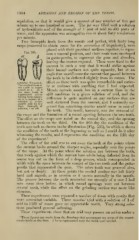Page 994 - My FlipBook
P. 994
1004 ABBASION AND EROSION OF THE TEETH.
regulation, so that it would give a current of any number of feet per
minute up to one hundred or more. The jar was filled with a solution
of hydrochloric acid of the strength of 1 part of acid to 400 parts of
water, and the apparatus was arranged to run at about forty revolutions
per minute.
Two bicuspids fresh from the mouth and perfect, with fairly long
cusps (removed to obtain room for the correction of iregularity), were
placed with their proximal surfaces together, to repre-
FiG. 535. .^ 2iatural position, and their roots were enveloped
ggj^|.
in gutta-percha, to represent the gum and alveolus,
leaving the crowns exposed. These were fixed in the
current in such a way that it would strike against
their buccal surfaces not quite squarely, but at an
angle that would cause tlie current that passed between
the teeth to be deflected slightly from its course. The
Artificial Erosion, effect ou thcsc tcctli was quitc remarkable and entire-
Ihe ZlfhV^i^lrl h at variance with anything that I had expected.
sented at a. At b Metals corrodc much less in a current than in the
the same tooth is .,, ,.. . . ,. „ . , t ,^
represented after stlU COUdltlOn lU a glVCD SOlutlOU ot aCld, aucl the
ed7o a 'cun'ent ^of a difference is quite marked on any surfaces that are
^ell sheltered from the current, and I naturally ex-
chiori^°acW for'five'
days, strength of pectcd that something similar would occur in case of
the teeth. The result, however, was the removal of
the cusps and the formation of a round opening between the two teeth.
The effect on the cusps was noted on the second day, and the opening
between the teeth on the third. On the fifth day the condition of the
teeth was such as shown in the illustration (Fig. 535), in which a shows
the condition of the tooth at the beginning as well as I could do it after
witnessing tiie results, and 6 represents the condition on the fifth day
of the experiment.^
The effect of the acid was to cut away the teeth at the points where
the current broke around the sharper angles, especially over the points
of the cusps. At the point where the solution ran between the teeth,
that tooth against which the current bore while being deflected from its
course was cut in the form of a deep groove, which corresponded in
width with the space between the contact of the two teeth and the gutta-
percha that represented the gum. The other tooth was grooved also,
but not so deeply. At these points the eroded surface was left fairly
hard and smooth, as in erosion as it occurs naturally in the mouth.
The groove betNveen the teeth reminded me strongly of a case T had
seen some time before, in which round openings were cut between
several teeth, while the effect on the grinding surface was more like
abrasion.
These experiments were repeated a number of times with results that
were somewhat variable. Three months' trial with a solution of 1 of
acid to 1 500 of water gave no appreciable result. Very strong solu-
tions produced general softening.
These experiments show that an acid may possess an action under a
' These figures are made from the drawinsrs that aecompany my notes of the experi-
ments made at the time. I have represented only the tooth inost eroded.


